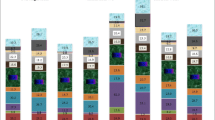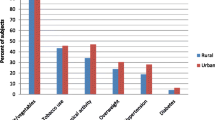Abstract
The objective of the study was to explore gender differences in the risk factors of non-communicable diseases among medical students in Nepal. We randomly selected two private and one government medical college located in Kathmandu Valley. All the third year medical students (n = 191) from these selected colleges were requested to participate in an anonymous cross sectional survey. We gathered information about different risk factors for non-communicable diseases including smoking and drinking habits, physical activity and fruit and vegetable consumption. We identified significant gender differences in the clustering of modifiable risk factors among our study population (p value = 0.032). Logistic regression model showed that male and female medical students were significantly different in terms of smoking status [aOR = 4.12, 95 % confidence interval (CI) 1.57; 10.85] and high level of physical activity (aOR = 4.50, 95 % CI 1.80; 11.21). Male medical students should be targeted in future behavioral interventions for smoking cessation, while physical activity among female medical students needs to be promoted.
Similar content being viewed by others
References
Alwan, A., Armstrong, T., Bettcher, D., et al. (2011). Global status report on noncommunicable diseases 2010. Geneva: WHO.
WHO South-East Asia Region. (2014). Noncommunicable diseases are the no. 1 killers in the South-East Asia Region. http://www.searo.who.int/entity/noncommunicable_diseases/en/. Accessed 23 March 2014.
Bhandari, G. P., Angdembe, M. R., Dhimal, M., Neupane, S., & Bhusal, C. (2014). State of non-communicable diseases in Nepal. BMC Public Health, 14(1), 23.
Miranda, J. J., Kinra, S., Casas, J. P., Davey Smith, G., & Ebrahim, S. (2008). Non-communicable diseases in low- and middle-income countries: context, determinants and health policy. Tropical Medicine & International Health, 13(10), 1225–1234.
Khuwaja, A. K., & Kadir, M. M. (2010). Gender differences and clustering pattern of behavioural risk factors for chronic non-communicable diseases: community-based study from a developing country. Chronic Illness, 6(3), 163–170.
Ghimire, A., Sharma, B., Niraula, S. R., Devkota, S., & Pradhan, P. M. (2013). Smoking habit among male medical and dental students of B.P. Koirala Institute of Health Sciences, Nepal. Kathmandu University Medical Journal, 11(41), 32–36.
Giri, S., Sharma, S. R., Timalsina, S., et al. (2012). Cardiovascular health risk behavior among medical students in a teaching hospital. Journal of Nepal Health Research Council, 10(22), 187–191.
Shyangwa, P. M., Joshi, D., & Lal, R. (2007). Alcohols and other substance use/abuse among junior doctors and medical students in a teaching institute. Journal of the Nepal Medical Association, 46(167), 126–129.
Slusser, M. S., & Slusser, M. (1982). Nepal mandala: A cultural study of the Kathmandu Valley. Princeton: Princeton University Press.
Central Bureau of Statistics. (2011). National population and housing census 2011. Kathmandu: CBS.
Medical Colleges in Nepal. (2013). List of Medical Colleges in Nepal. http://www.medicalcollegesnepal.com/category/list-of-colleges/page/3/. Accessed March 9, 2014.
Ministry of Health and Population (DoHS). (2008). Society for Local Integrated Development Nepal (SOLID Nepal), WHO. Nepal Non Communicable Disease Risk Factor Survey. Kathmandu: MoHP, SOLID Nepal and WHO.
Oli, N., Vaidya, A., & Thapa, G. (2013). Behavioural risk factors of noncommunicable diseases among Nepalese urban poor: A descriptive study from a slum area of Kathmandu. Epidemiology Research International. doi:10.1155/2013/329156.
World Health Organization. (2008). WHO steps instrument question-by-question guide (core and expanded). Geneva, Switzerland: World Health Organization.
Bush, J., White, M., Kai, J., Rankin, J., & Bhopal, R. (2003). Understanding influences on smoking in Bangladeshi and Pakistani adults: Community based, qualitative study. BMJ, 326(7396), 962.
Weiss, J. W., Palmer, P. H., Chou, C. P., Mouttapa, M., & Johnson, C. A. (2008). Association between psychological factors and adolescent smoking in seven cities in China. International Journal of Behavioral Medicine, 15(2), 149–156.
Budhathoki, N., Shrestha, M. K., Acharya, N., & Manandhar, A. (2010). Substance use among third year medical students of Nepal. Journal of Nepal Health Research Council, 8(1), 15–18.
Khanal, P., Ghimire, R. H., Gautam, B., et al. (2010). Substance use among medical students in Kathmandu valley. Journal of the Nepal Medical Association, 50(180), 267–272.
Sreeramareddy, C. T., Suri, S., Menezes, R. G., et al. (2010). Self-reported tobacco smoking practices among medical students and their perceptions towards training about tobacco smoking in medical curricula: A cross-sectional, questionnaire survey in Malaysia, India, Pakistan, Nepal, and Bangladesh. Substance Abuse Treatment, Prevention, and Policy, 5, 29.
Anand, T., Tanwar, S., Kumar, R., Meena, G. S., & Ingle, G. K. (2011). Knowledge, attitude, and level of physical activity among medical undergraduate students in Delhi. Indian Journal of Medical Sciences, 65(4), 133–142.
Rao, C. R., Darshan, B., Das, N., Rajan, V., Bhogun, M., & Gupta, A. (2012). Practice of physical activity among future doctors: A cross sectional analysis. International Journal of Preventive Medicine, 3(5), 365–369.
Rejali, M., & Mostajeran, M. (2013). Assessment of physical activity in medical and public health students. Journal of Education and Health Promotion, 2, 19.
Jafar, T. H. (2006). Women in Pakistan have a greater burden of clinical cardiovascular risk factors than men. International Journal of Cardiology, 106(3), 348–354.
Vikram, N. K., Tandon, N., Misra, A., et al. (2006). Correlates of Type 2 diabetes mellitus in children, adolescents and young adults in north India: A multisite collaborative case–control study. Diabetic Medicine: A Journal of the British Diabetic Association, 23(3), 293–298.
Acknowledgments
We would like to thank Department of Community Medicine and Public Health of Institute of Medicine, all the medical colleges we visited and the participants of the study. This paper is based on cross-sectional study data collected to explore the risk factors of major non-communicable diseases among medical students in Nepal.
Conflict of interest
None.
Author information
Authors and Affiliations
Corresponding author
Additional information
Aditya Sakya and Shiva Raj Mishra shared first authorship.
Rights and permissions
About this article
Cite this article
Shakya, A., Mishra, S.R., Giri, S. et al. Gender Differences and Clustering of Modifiable Risk Factors of Non-communicable Diseases Among Medical Students: A Cross Sectional Study in Nepal. J Community Health 40, 147–152 (2015). https://doi.org/10.1007/s10900-014-9912-0
Published:
Issue Date:
DOI: https://doi.org/10.1007/s10900-014-9912-0




